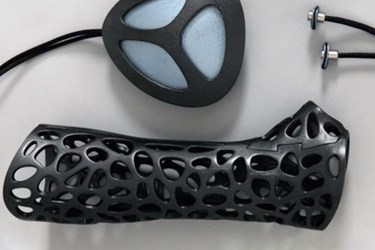Could A 3D Printed Cast Speed Healing?
By Joel Lindsey

Turkish industrial designer Deniz Karasahin has designed a lightweight, breathable, 3D-printed cast that works in tandem with ultrasound technology to speed the bone-healing process.
Although the device is only a prototype, it recently won the A'Design Award in the 3D printed forms and products design category. When used for 20 minutes a day, the system promises to reduce the healing process duration by up to 38 percent and increase the rate of healing by up to 80 percent in non-union fractures, according to the product description on the A'Design Award website.
To facilitate this improved healing process, the new cast design — called Osteoid — uses data from a detailed scan of the broken limb to create a 3D-printed two-piece, snap-together cast. The cast’s lattice-like design is lighter and more breathable than traditional plaster casts. Additionally, the open holes of the cast allow for low intensity pulsed ultrasound (LIPUS) leads to be attached to the underlying skin. Pulsing waves of ultrasound are then directed through the cast and into the injury site, helping speed up the body’s natural healing processes.
“In order to function, the LIPUS ultrasound probes have to be placed on the injured area with direct skin contact,” said the Osteoid product description. “Because of this requirement it was not possible to use this method with patients using standard medical casts. Now thanks to the ventilation holes on the Osteoid medical cast the LIPUS bone stimulator probes can be placed over the injured area.”
Karasahin’s design builds on a small but growing body of research aimed at exploring the medical potential of LIPUS.
“We know that ultrasound works,” Michael Hausman, a hand surgeon at Mount Sinai Hospital in New York City and proponent of ultrasound treatment, said in an article published recently by Fast Company. “There’s good evidence, presented most recently in two papers published in the Journal of Bone and Joint Surgery, the leading journal in orthopedics.”
Hausman said that the articles provided evidence of decreased healing times when ultrasound therapy was used to help treat broken tibias and wrist fractures. He also said that the Osteoid design could significantly change the field of orthopedics, but he points out that the new design is more costly than traditional plaster casts.
Although the Osteoid is still only a prototype and is continuing to be developed and fine-tuned, it recently won the A’Design Award in the 3D printed forms and products design category.
Given the early success of the Osteoid design and the increasing popularity of 3D printing for medical applications, many hope to see the new cast, or something similar to it, move into some form of clinical use in the near future, CNET reported.
Image Credit: Deniz Karasahin from A' Design Award & Competition
